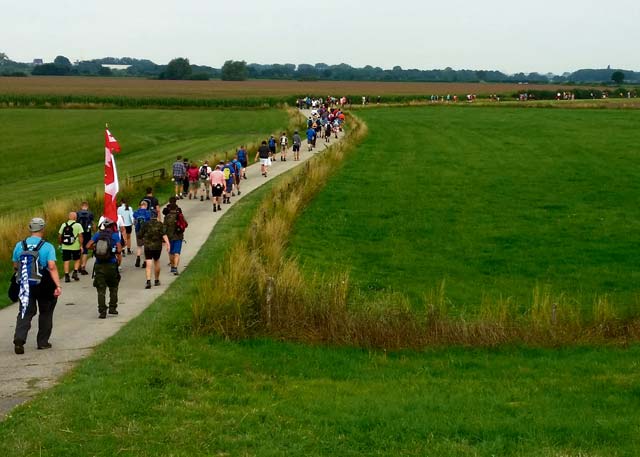
The annual Nijmegen “Vierdaagse,” the Four Days Marches, in the Netherlands is an event regional marching enthusiasts and service members, among others, look forward to all year. For some, it is a chance to prove their strength and resiliency. For others, it is a chance to join thousands of other marchers in the world’s largest walking event and earn a coveted ribbon. Regardless of the reason, everyone must complete his or her individual distance — and 30 to 50 km a day is no small feat.
Seventeen Soldiers from the 21st Theater Sustainment Command’s 7th Civil Support Command, 30th Medical Brigade and 16th Sustainment Brigade, participated in the 99th annual running of the march event this year July 21 to 24 in Nijmegen, the Netherlands.
Soldiers had three choices of how to conduct their march: individual military, military detachment or civilian individual. Those marching as individual military or as part of a military detachment completed a 40 km route each day in uniform with a 22-pound rucksack. Those who chose the civilian option marched a 50 km route without a pack. Another choice, a 30 km option, was available to elderly participants and adolescents.
Walkers determined their own marching destiny. Soldiers from the 212th Combat Support Hospital, 30th Med. Bde., marched as a 12-Soldier detachment. During the walk, members of the team hailed the event as a chance to showcase the resiliency of the U.S. Army and build team camaraderie.
“This is a great chance to build up the team. We have members from different sections of the hospital here, and it’s a great opportunity to work together and motivate each other,” said Capt. Robert E. Gallimore, 212th CSH battalion officer. “These events mirror what we as Soldiers do as a part of U.S. Army Europe. We are walking as a military team, surrounded by fellowship of other European nations.”
Soldiers marching in “civilian” status were required to find their own lodging during the event. Those conducting the march in uniform had another option.
“Soldiers marching in uniform during the Vierdaagse are also authorized to stay on the military camp Heumensoord where they are provided with food, showers and a bunk to sleep in,” said Dutch army Cpl. Dennis Fijnvandraat, a medic assigned to the Dutch army’s 471st Mobile Hospital Operations Group. “This is my third time marching, once as a part of a military detachment, and twice as a civilian.”
Soldiers walked a different route each day through areas surrounding Nijmegen, ending in the Nijmegen city center at the end of the day’s march. The 50 km and 40 km military walkers began each morning at 4 and 4:30 a.m. respectively, and all walkers were required to check back in with event officials by 5 p.m. or be disqualified.
“On our first day, we made it to the finish on time, but we were cutting it close,” said Staff Sgt. Walter Egan, an all-wheel mechanic assigned to the 7th CSC’s 361st Civil Affairs Brigade. “Each day of the march brings its own challenges, so it is important to train and budget your time so you make it on time each day.”
Participants in the march enjoyed views of the Dutch countryside and support from the villages they passed through each day. No matter the time of day, from the early morning into the sweltering heat of the afternoon, residents from the village were outside passing out candy, refilling water sources and cheering on members of the march.
“It’s really motivating to see the support we get from these villages as we walk through,” Egan said. “Marching 50 km is hard, but hearing all the locals cheer for us makes it a little easier.”
The event culminated in an extended march through the Nijmegen city center, Via Gladiola. The walkers, who walked the final few kilometers of their journey, were showered with gladiolus flowers as they passed thousands of spectators. These flowers represented victory, a tradition derived from the Roman times.
“As you come through the center of Nijmegen, cross the finish line and throw the gladiolus flowers you got during the march onto the giant pile in the center of the Wedren (the area where marchers start and finish each day), you know that you’ve accomplished something amazing,” Egan said.
Next year marks the 100th Four Days Marches and is expected to attract more than 50,000 participants. Those marching as civilians are only guaranteed entry if they have successfully completed the march four times in the past five years, and all military applicants will gain entry provided there are spaces available. All other applicants will be subject to a lottery.
“This march proves a Soldier’s resiliency, gives all participants a chance to walk among military members and civilians from all over the world and is one of the most unique experiences I’ve ever been a part of,” Egan said. “I am going to do everything I can to make sure I march again next year.”







